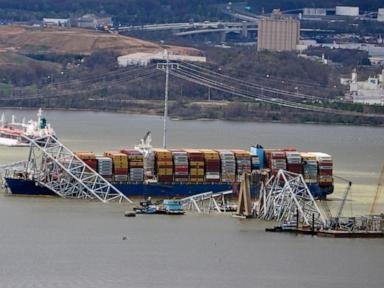BALTIMORE — A third body has been found at the site of last week’s bridge collapse in Baltimore.
Meanwhile, a tentative timeline has been released for how soon authorities believe they can reopen crucial commercial shipping channels.
President Joe Biden also visited the port city. And federal and state authorities are ramping up efforts to soften the economic blow to businesses and residents who work in Maryland’s maritime industry.
Here’s what we know as cleanup efforts get underway:
Authorities announced Friday evening that salvage divers recovered a third body from the water, identified as 38-year-old Maynor Yasir Suazo-Sandoval, one of the missing workers. His body was found around 10:30 a.m..
Maryland State Police Superintendent Col. Roland L. Butler said authorities are committed to recovering the bodies of the three workers who remain missing.
“While I take solace in knowing this brings us one step closer to closure, my heart continues to be with all the families still waiting anxiously for their loved ones,” Baltimore Mayor Brandon Scott said in a statement.
Engineers said Thursday that they expect to restore navigation in and out of the Port of Baltimore by the end of this month.
The Francis Scott Key Bridge collapsed within seconds on March 26 after being struck by the cargo ship Dali, which lost power shortly after leaving Baltimore.
The U.S. Army Corps of Engineers said it expects to open a limited access channel in the next four weeks. It would support barge container service and some vessels that move automobiles and farm equipment to and from the port.
The agency is aiming to reopen a permanent navigation channel by the end of May, which would restore port access to normal capacity.
Lt. Gen. Scott Spellmon, USACE commanding general, has acknowledged the timelines are “ambitious” and may still be impacted by adverse weather or “changes in the complexity of the wreckage.”
As for the search for the bodies of the missing, weather conditions and the river’s murky water have been making the task difficult.
President Biden got a firsthand look Friday at efforts to clear away the hulking remains of the bridge. From aboard the Marine One helicopter, the president circled the Key Bridge’s warped steel trusses as well as the cranes, ships and other equipment that are trying to clear the wreckage.
On the ground, Biden received updates on the cleanup and the collapse’s larger impact on the region from local officials, as well as the U.S. Coast Guard and Army Corps of Engineers.
“I’m here to say your nation has your back and I mean it,” Biden said from the shoreline.
Eight workers — all immigrants from Mexico, Guatemala, Honduras or El Salvador — were filling potholes on the span when it collapsed. Only two of them survived. The president met Friday with the workers’ families near the bridge, the White House said.
“The damage is devastating, and our hearts are still breaking,” Biden said.
The White House also announced that it’s asking Congress to authorize the federal government to cover 100% of the cleanup and reconstruction costs, rather than seeking funding through a separate, supplemental funding request.
Authorization is likely no slam-dunk in Congress. And funding questions carry political implications as Biden squares off with former President Donald Trump in November’s election.
Isabel Casillas Guzman, the administrator of the U.S. Small Business Administration, visited Baltimore on Thursday to highlight a low-interest loan program that’s available to affected businesses.
The program has received 500 applications, Guzman said, and the funds could start being distributed within about two weeks.
The loans will help keep companies afloat as Baltimore’s vital port remains closed to most maritime traffic. Guzman said businesses involved in transportation and supply chain logistics will likely suffer the most in the short term, but the long-term ripple effects will be widespread.
Baltimore’s port handles more cars and farm equipment than any other similar facility in the country, and the disaster has created logistical problems up and down the East Coast.
Their deaths have raised questions about whether the company they worked for took proper precautions, including keeping a safety boat nearby that might have been able to warn them at least a few seconds before impact.
Federal regulations require construction companies to keep such boats, commonly known as skiffs, on hand whenever crews are working over waterways, safety experts told The Associated Press. There is no indication that the company, Brawner, had a rescue boat on the water or ready to be launched as the bridge fell.
Even if the workers had been warned that the giant ship was about to hit, it’s unclear if they would have had enough time to scramble to safety.
A Brawner representative declined to comment, saying the company is focused on taking care of the families of the workers.
